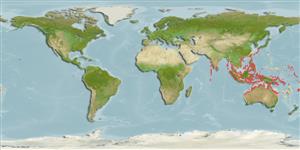Common names from other countries
>
Eupercaria/misc (Various families in series Eupercaria) >
Labridae (Wrasses) > Corinae
Etymology: Stethojulis: Greek, stetho, stethion = brest; literal = to prick a little breast + Greek, ioulis, a fish dealing with genera Coris or Thalassoma (Ref. 45335).
More on authors: Bloch & Schneider.
Environment: milieu / climate zone / depth range / distribution range
Ecología
marino asociado a arrecife; rango de profundidad 0 - 20 m (Ref. 37816). Tropical; 10°N - 25°S
Indo-West Pacific: Red Sea, Maldives to Samoa and Palau, north to Tokara Island, Japan, south to Montague Island (Australia).
Length at first maturity / Tamaño / Peso / Age
Maturity: Lm 9.0 range ? - ? cm
Max length : 16.5 cm TL macho / no sexado; (Ref. 48600)
Espinas dorsales (total) : 9; Radios blandos dorsales (total) : 11; Espinas anales: 3; Radios blandos anales: 11. Females spotted, males with lines (Ref. 48636).
Often found on exposed reefs with shallow clear water. Usually swim in loose groups along upper parts of drop-offs or above reef crests (Ref. 48636). May also be found solitary or in pairs (Ref. 90102). Minimum depth reported from Ref. 90102.
Life cycle and mating behavior
Maturities | Reproducción | Spawnings | Egg(s) | Fecundities | Larva
Oviparous, distinct pairing during breeding (Ref. 205). Pelagic spawner (Ref. 32193).
Randall, J.E., 2000. Revision of the Indo-Pacific labrid fishes of the genus Stethojulis, with descriptions of two new species. Indo-Pac. Fish. (31):42 p. (Ref. 36378)
IUCN Red List Status (Ref. 130435)
CITES (Ref. 128078)
Not Evaluated
Threat to humans
Harmless
Human uses
Pesquerías: pesquerías de subsistencia; Acuario: Comercial
Herramientas
Special reports
Download XML
Fuentes de Internet
Estimates based on models
Preferred temperature (Ref.
115969): 26.7 - 29.3, mean 28.7 (based on 1965 cells).
Phylogenetic diversity index (Ref.
82804): PD
50 = 0.5010 [Uniqueness, from 0.5 = low to 2.0 = high].
Bayesian length-weight: a=0.01023 (0.00572 - 0.01832), b=3.10 (2.95 - 3.25), in cm Total Length, based on LWR estimates for this species & Genus-body shape (Ref.
93245).
Nivel trófico (Ref.
69278): 3.2 ±0.3 se; based on diet studies.
Resiliencia (Ref.
120179): Alto, población duplicada en un tiempo mínimo inferior a 15 meses (K>1).
Fishing Vulnerability (Ref.
59153): Low vulnerability (13 of 100).
